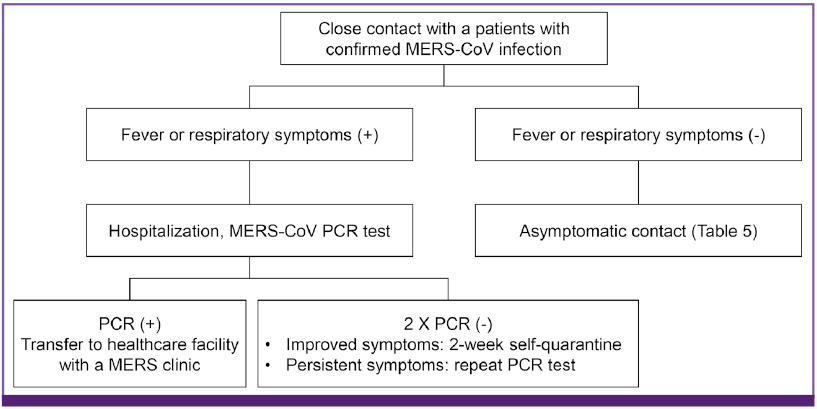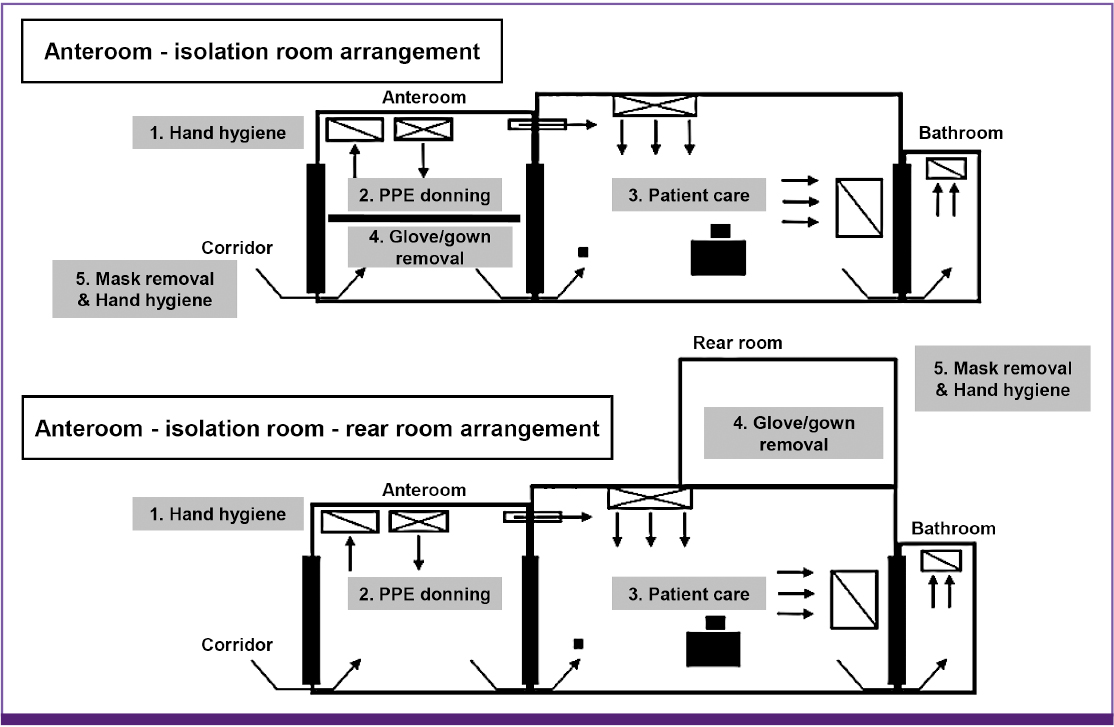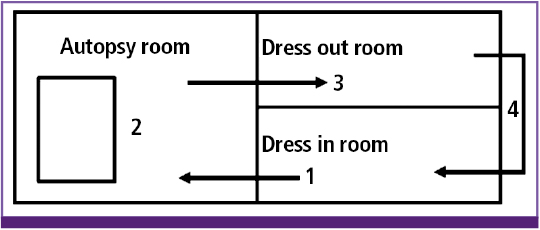Middle East Respiratory Syndrome Infection Control and Prevention Guideline for Healthcare Facilities
- Affiliations
-
- 1Division of Infectious Diseases, Department of Internal Medicine, Incheon Medical Center, Incheon, Korea.
- 2Division of Infectious Diseases, Department of Internal Medicine, Guro Hospital, Korea University College of Medicine, Seoul, Korea. heejinmd@medimail.co.kr
- 3Division of Infectious Diseases, Department of Internal Medicine, Anam Hospital, Korea University College of Medicine, Seoul, Korea.
- 4Division of Infectious Diseases, Department of Internal Medicine, Seoul Hospital, Chung-Ang University College of Medicine, Seoul, Korea.
- 5Division of Infectious Diseases, Department of Internal Medicine, Gangnam Severance Hospital, Yonsei University College of Medicine, Seoul, Korea.
- 6Department of Infection Control, Korea University Guro Hospital, Seoul, Korea.
- 7Department of Infection Control, Ewha Womens University Mokdong Hospital, Seoul, Korea.
- 8Keonyang University College of Nursing, Daejeon, Korea.
- 9Department of Infection Control, Konkuk University Seoul Hospital, Seoul, Korea.
- 10Catholic University of Korea College of Nursing, Seoul, Korea.
- 11Division of Infectious Diseases, Department of Internal Medicine, Seoul Metropolitan Government Seobuk Hospital, Seoul, Korea.
- 12Division of Infectious Diseases, Department of Internal Medicine, Yonsei University College of Medicine, Seoul, Korea.
- 13Division of Infectious Diseases, Department of Internal Medicine, Soonchunhyang University College of Medicine, Seoul, Korea.
- 14Division of Infectious Diseases, Department of Internal Medicine, Ajou University School of Medicine, Suwon, Korea.
- 15Department of Internal Medicine, Seoul National University College of Medicine, Seoul, Korea.
- 16Division of Infectious Diseases, Department of Internal Medicine, Eulji University Hospital, Daejeon, Korea.
- 17Division of Infectious Diseases, Department of Internal Medicine, Kangnam Sacred Heart Hospital, Hallym University College of Medicine, Seoul, Korea.
- 18Division of Infectious Diseases, Department of Internal Medicine, Kangdong Sacred Heart Hospital, Hallym University College of Medicine, Seoul, Korea.
- 19Department of Infectious Diseases, Asan Medical Center, University of Ulsan College of Medicine, Seoul, Korea.
- 20Division of Infectious Diseases, Department of Internal Medicine, Kangwon National University School of Medicine, Chucheon, Korea.
- 21Division of Infectious Diseases, Department of Internal Medicine, College of Medicine, The Catholic University of Korea, Seoul, Korea.
- KMID: 2170508
- DOI: http://doi.org/10.3947/ic.2015.47.4.278
Abstract
- Middle East Respiratory Syndrome (MERS) is an acute viral respiratory illness with high mortality caused by a new strain of betacoronavirus (MERS-CoV). Since the report of the first patient in Saudi Arabia in 2012, large-scale outbreaks through hospital-acquired infection and inter-hospital transmission have been reported. Most of the patients reported in South Korea were also infected in hospital settings. Therefore, to eliminate the spread of MERS-CoV, infection prevention and control measures should be implemented with rigor. The present guideline has been drafted on the basis of the experiences of infection control in the South Korean hospitals involved in the recent MERS outbreak and on domestic and international infection prevention and control guidelines. To ensure efficient MERS-CoV infection prevention and control, care should be taken to provide comprehensive infection control measures including contact control, hand hygiene, personal protective equipment, disinfection, and environmental cleaning.
Keyword
MeSH Terms
Figure
Cited by 5 articles
-
A Lesson from Temporary Closing of a Single University-affiliated Hospital owing to In-Hospital Transmission of Coronavirus Disease 2019
Heayon Lee, Jung Won Heo, Sei Won Kim, Jehoon Lee, Jung Hyun Choi
J Korean Med Sci. 2020;35(13):e145. doi: 10.3346/jkms.2020.35.e145.Revised Triage and Surveillance Protocols for Temporary Emergency Department Closures in Tertiary Hospitals as a Response to COVID-19 Crisis in Daegu Metropolitan City
Han Sol Chung, Dong Eun Lee, Jong Kun Kim, In Hwan Yeo, Changho Kim, Jungbae Park, Kang Suk Seo, Sin-Yul Park, Jung Ho Kim, Gyunmoo Kim, Suk Hee Lee, Jeon Jae Cheon, Yang Hun Kim
J Korean Med Sci. 2020;35(19):e189. doi: 10.3346/jkms.2020.35.e189.Collaborative Intervention of Middle East Respiratory Syndrome: Rapid Response Team
Jacob Lee, , Woo Joo Kim
Infect Chemother. 2016;48(2):71-74. doi: 10.3947/ic.2016.48.2.71.Outbreaks of Middle East Respiratory Syndrome in Two Hospitals Initiated by a Single Patient in Daejeon, South Korea
Sun Hee Park, Yeon-Sook Kim, Younghee Jung, Soo young Choi, Nam-Hyuk Cho, Hye Won Jeong, Jung Yeon Heo, Ji Hyun Yoon, Jacob Lee, Shinhye Cheon, Kyung Mok Sohn
Infect Chemother. 2016;48(2):99-107. doi: 10.3947/ic.2016.48.2.99.Outbreaks of Middle East Respiratory Syndrome in Two Hospitals Initiated by a Single Patient in Daejeon, South Korea
Sun Hee Park, Yeon-Sook Kim, Younghee Jung, Soo young Choi, Nam-Hyuk Cho, Hye Won Jeong, Jung Yeon Heo, Ji Hyun Yoon, Jacob Lee, Shinhye Cheon, Kyung Mok Sohn
Infect Chemother. 2016;48(2):99-107. doi: 10.3947/ic.2016.48.2.99.
Reference
-
1. The Korean Society of Infectious Diseases. Korean Society for Healthcare-associated Infection Control and Prevention. An unexpected outbreak of Middle East respiratory syndrome coronavirus infection in the Republic of Korea, 2015. Infect Chemother. 2015; 47:120–122.2. Chong YP, Song JY, Seo YB, Choi JP, Shin HS. Rapid Response Team. Antiviral treatment guidelines for Middle East respiratory syndrome. Infect Chemother. 2015; 47:212–222.
Article3. Cowling BJ, Park M, Fang VJ, Wu P, Leung GM, Wu JT. Preliminary epidemiological assessment of MERS-CoV outbreak in South Korea, May to June 2015. Euro Surveill. 2015; 20:7–13.
Article4. Oboho IK, Tomczyk SM, Al-Asmari AM, Banjar AA, Al-Mugti H, Aloraini MS, Alkhaldi KZ, Almohammadi EL, Alraddadi BM, Gerber SI, Swerdlow DL, Watson JT, Madani TA. 2014 MERS-CoV outbreak in Jeddah--a link to health care facilities. N Engl J Med. 2015; 372:846–854.
Article5. Jefferson T, Del Mar CB, Dooley L, Ferroni E, Al-Ansary LA, Bawazeer GA, van Driel ML, Nair S, Jones MA, Thorning S, Conly JM. Physical interventions to interrupt or reduce the spread of respiratory viruses. Cochrane Database Syst Rev. 2011; CD006207.
Article6. Rasmussen SA, Gerber SI, Swerdlow DL. Middle East respiratory syndrome coronavirus: update for clinicians. Clin Infect Dis. 2015; 60:1686–1689.
Article7. World Health Organization (WHO). Infection prevention and control during health care for probable and confirmed cases of novel coronavirus (nCov) infection. Accessed 16 July 2015. Available at: http://www.who.int/csr/disease/coronavirus_infections/IPCnCoVguidance_06May13.pdf.8. Aliabadi AA, Rogak SN, Bartlett KH, Green SI. Preventing airborne disease transmission: review of methods for ventilation design in health care facilities. Adv Prev Med. 2011; 2011:124064.
Article9. Azhar EI, Hashem AM, El-Kafrawy SA, Sohrab SS, Aburizaiza AS, Farraj SA, Hassan AM, Al-Saeed MS, Jamjoom GA, Madani TA. Detection of the Middle East respiratory syndrome coronavirus genome in an air sample originating from a camel barn owned by an infected patient. MBio. 2014; 5:e01450–e01414.
Article10. World Health Organization (WHO). Middle East respiratory symdrome coronavirus (MERS-CoV): update. Accessed 16 July 2015. Available at: http://www.who.int/csr/don/2014_04_11_mers/en/#.11. World Health Organization (WHO). Infection prevention and control of epidemic-and pandemic prone acute respiratory infections in health care: WHO guidelines. Accessed 16 July 2015. Available at: http://www.who.int/csr/bioriskreduction/infection_control/publication/en/.12. Hughes JM. Study on the efficacy of nosocomial infection control (SENIC Project): results and implications for the future. Chemotherapy. 1988; 34:553–561.
Article13. Health information and quality authority (HIQA). National standards for the prevention and control of healthcare associated infections. Accessed 16 July 2015. Available at: http://www.hiqa.ie/system/files/National_Standards_Prevention_Control_Infections.pdf.14. Madge P, Paton JY, McColl JH, Mackie PL. Prospective controlled study of four infection-control procedures to prevent nosocomial infection with respiratory syncytial virus. Lancet. 1992; 340:1079–1083.
Article15. Public Health Agency of Canada. Interim guidance-middle east respiratory syndrome coronavirus (MERS-Cov). Accessed 16 July 2015. Available at: http://www.phac-aspc.gc.ca/eri-ire/coronavirus/guidance-directives/nCoV-ig-dp-eng.php.16. Chen M, Leo YS, Ang B, Heng BH, Choo P. The outbreak of SARS at Tan Tock Seng Hospital--relating epidemiology to control. Ann Acad Med Singapore. 2006; 35:317–325.17. Lau JT, Fung KS, Wong TW, Kim JH, Wong E, Chung S, Ho D, Chan LY, Lui SF, Cheng A. SARS transmission among hospital workers in Hong Kong. Emerg Infect Dis. 2004; 10:280–286.
Article18. Larson EL, Bryan JL, Adler LM, Blane C. A multifaceted approach to changing handwashing behavior. Am J Infect Control. 1997; 25:3–10.
Article19. Pittet D, Hugonnet S, Harbarth S, Mourouga P, Sauvan V, Touveneau S, Perneger TV. Effectiveness of a hospital-wide programme to improve compliance with hand hygiene. Infection Control Programme. Lancet. 2000; 356:1307–1312.
Article20. World Health Organization (WHO). Essential environmental health standards in health care. Accessed 16 July 2015. Available at: http://www.who.int/water_sanitation_health/hygiene/settings/ehs_hc/en/.21. World Health Organization (WHO). Natural ventilation for infection control in health-care settings: WHO guidelines 2009. Accessed 16 July 2015. Available at: http://www.who.int/water_sanitation_health/publications/natural_ventilation/en/index.html.22. Booth TF, Kournikakis B, Bastien N, Ho J, Kobasa D, Stadnyk L, Li Y, Spence M, Paton S, Henry B, Mederski B, White D, Low DE, McGeer A, Simor A, Vearncombe M, Downey J, Jamieson FB, Tang P, Plummer F. Detection of airborne severe acute respiratory syndrome (SARS) coronavirus and environmental contamination in SARS outbreak units. J Infect Dis. 2005; 191:1472–1477.
Article23. Lai MY, Cheng PK, Lim WW. Survival of severe acute respiratory syndrome coronavirus. Clin Infect Dis. 2005; 41:e67–e71.
Article24. Pang X, Zhu Z, Xu F, Guo J, Gong X, Liu D, Liu Z, Chin DP, Feikin DR. Evaluation of control measures implemented in the severe acute respiratory syndrome outbreak in Beijing, 2003. JAMA. 2003; 290:3215–3221.
Article25. Centers for Disease Control and Prevention (CDC). Respiratory hygiene/cough etiquette in healthcare settings. Accessed 16 July 2015. Available at: http://www.cdc.gov/flu/professionals/infectioncontrol/resphygiene.htm.26. Gopalakrishna G, Choo P, Leo YS, Tay BK, Lim YT, Khan AS, Tan CC. SARS transmission and hospital containment. Emerg Infect Dis. 2004; 10:395–400.
Article27. Hui DS, Peiris M. Middle East Respiratory Syndrome. Am J Respir Crit Care Med. 2015; 192:278–279.
Article28. Jensen PA, Lambert LA, Iademarco MF, Ridzon R, Cdc . Guidelines for preventing the transmission of Mycobacterium tuberculosis in health-care settings, 2005. MMWR Recomm Rep. 2005; 54:1–141.29. Leung TF, Ng PC, Cheng FW, Lyon DJ, So KW, Hon EK, Li AM, Li CK, Wong GW, Nelson EA, Hui J, Sung RY, Yam MC, Fok TF. Infection control for SARS in a tertiary paediatric centre in Hong Kong. J Hosp Infect. 2004; 56:215–222.
Article30. Garner JS. Guideline for isolation precautions in hospitals. The Hospital Infection Control Practices Advisory Committee. Infect Control Hosp Epidemiol. 1996; 17:53–80.31. Centers for Disease Control and Prevention (CDC). Interim infection prevention and control recommendations for hospitalized patients with Middle East respiratory syndrome coronavirus((MERS-CoV). Accessed 16 July 2015. Available at: http://www.cdc.gov/coronavirus/mers/downloads/MERS-Infection-Control-Guidance-051414.pdf.32. Siegel JD, Rhinehart E, Jackson M, Chiarello L. 2007 guideline for isolation precautions: preventing transmission of infectious agents in health care settings. Am J Infect Control. 2007; 35:10 Suppl 2. S65–S164.
Article33. Public Health England. MERS-CoV: infection control for possible or confirmed cases. Accessed 16 July 2015. Available at: https://www.gov.uk/government/publications/merscov-infection-control-for-possible-or-confirmed-cases.34. Ministry of Health Saudi Arabia. Infection prevention/control and management guidelines for patients with Middle East Respiratory Syndrome Coronavirus (MERS-CoV) Infection. Accessed 16 July 2015. Available at: http://www.moh.gov.sa/en/CCC/StaffRegulations/Corona/Documents/GuidelinesforCoronaPatients.pdf.35. Healthcare Infection Control Practices Advisory Committee. 2007 guideline for isolation precautions: preventing transmission of infectious agents in healthcare settings. Accessed 16 July 2015. Available at: http://www.cdc.gov/hicpac/pdf/isolation/Isolation2007.pdf.36. Tran K, Cimon K, Severn M, Pessoa-Silva CL, Conly J. Aerosol generating procedures and risk of transmission of acute respiratory infections to healthcare workers: a systematic review. PLoS One. 2012; 7:e35797.
Article37. Khoo KL, Leng PH, Ibrahim IB, Lim TK. The changing face of healthcare worker perceptions on powered air-purifying respirators during the SARS outbreak. Respirology. 2005; 10:107–110.
Article38. Sehulster L, Chinn RY. CDC. HICPAC. Guidelines for environmental infection control in health-care facilities. Recommendations of CDC and the Healthcare Infection Control Practices Advisory Committee (HICPAC). MMWR Recomm Rep. 2003; 52:1–42.39. Assiri A, Al-Tawfiq JA, Al-Rabeeah AA, Al-Rabiah FA, Al-Hajjar S, Al-Barrak A, Flemban H, Al-Nassir WN, Balkhy HH, Al-Hakeem RF, Makhdoom HQ, Zumla AI, Memish ZA. Epidemiological, demographic, and clinical characteristics of 47 cases of Middle East respiratory syndrome coronavirus disease from Saudi Arabia: a descriptive study. Lancet Infect Dis. 2013; 13:752–761.
Article40. Guery B, Poissy J, el Mansouf L, Séjourné C, Ettahar N, Lemaire X, Vuotto F, Goffard A, Behillil S, Enouf V, Caro V, Mailles A, Che D, Manuguerra JC, Mathieu D, Fontanet A, van der Werf S. MERS-CoV study group. Clinical features and viral diagnosis of two cases of infection with Middle East Respiratory Syndrome coronavirus: a report of nosocomial transmission. Lancet. 2013; 381:2265–2272.
Article41. Krumkamp R, Duerr HP, Reintjes R, Ahmad A, Kassen A, Eichner M. Impact of public health interventions in controlling the spread of SARS: modelling of intervention scenarios. Int J Hyg Environ Health. 2009; 212:67–75.
Article42. Yen MY, Lin YE, Lee CH, Ho MS, Huang FY, Chang SC, Liu YC. Taiwan's traffic control bundle and the elimination of nosocomial severe acute respiratory syndrome among healthcare workers. J Hosp Infect. 2011; 77:332–337.
Article43. Yen MY, Lu YC, Huang PH, Chen CM, Chen YC, Lin YE. Quantitative evaluation of infection control models in the prevention of nosocomial transmission of SARS virus to healthcare workers: implication to nosocomial viral infection control for healthcare workers. Scand J Infect Dis. 2010; 42:510–515.
Article44. Chen SY, Chiang WC, Ma MH, Su CP, Hsu CY, Ko PC, Tsai KC, Yen ZS, Shih FY, Chen SC, Lin SJ, Wang JL, Chang SC, Chen WJ. Sequential symptomatic analysis in probable severe acute respiratory syndrome cases. Ann Emerg Med. 2004; 43:27–33.
Article45. Nolte KB, Taylor DG, Richmond JY. Biosafety considerations for autopsy. Am J Forensic Med Pathol. 2002; 23:107–122.
Article46. Medcraft JW, Hawkins JM, Fletcher BN, Dadswell JV. Potential hazard from spray cleaning of floors in hospital wards. J Hosp Infect. 1987; 9:151–157.
Article47. Centers for Disease Control and Prevention (CDC). Healthcare Infection Control Practices Advisory Committee (HICPAC). Guideline for Disinfection and Sterilization in Healthcare Facilities, 2008. Accessed 16 July 2015. Available at: http://www.cdc.gov/hicpac/Disinfection_Sterilization/toc.html.
- Full Text Links
- Actions
-
Cited
- CITED
-
- Close
- Share
- Similar articles
-
- Healthcare workers infected with Middle East respiratory syndrome coronavirus and infection control
- An Unexpected Outbreak of Middle East Respiratory Syndrome Coronavirus Infection in the Republic of Korea, 2015
- The Same Middle East Respiratory Syndrome-Coronavirus (MERS-CoV) yet Different Outbreak Patterns and Public Health Impacts on the Far East Expert Opinion from the Rapid Response Team of the Republic of Korea
- Middle East respiratory syndrome clinical practice guideline for hemodialysis facilities
- Middle East Respiratory Syndrome Coronavirus Superspreading Event Involving 81 Persons, Korea 2015





